HONDA S2000 2002 1.G Owners Manual
Manufacturer: HONDA, Model Year: 2002, Model line: S2000, Model: HONDA S2000 2002 1.GPages: 277, PDF Size: 4.81 MB
Page 121 of 277

During this period:Avoid full-throttle starts and rapid
acceleration.
Do not exceed 5,500 rpm f or the
f irst 600 miles (1,000 km) of
operation.
Avoidhardbraking.Newbrakes
need to be broken-in by moderate
use f or the f irst 200 miles (300
km).
Help assure your car’s f uture
reliability and perf ormance by paying
extra attention to how you drive
during the f irst 600 miles (1,000 km).
Using gasoline containing lead will
damage your car’s emissions
controls. This contributes to air
pollution.
In Canada, some gasolines contain
an octane-enhancing additive called
MMT. If you use such gasolines,
your emission control system
perf ormance may deteriorate and
the Malfunction Indicator Lamp on
your instrument panel may turn on.
If this happens, contact your
authorized Honda dealer f or service.
We recommend gasolines containing
detergent additives that help prevent
f uel system and engine deposits.
If you are unable to f ind premium
unleaded gasoline, you may substi-
tute an unleaded regular gasoline.
The engine will compensate f or the
lower octane, but you may notice a
slight decrease in power as a result.
Your Honda is designed to operate
on premium unleaded gasoline with a
pump octane number of 91 or higher.
Youshouldfollowthesesamere-
commendations with an overhauled
or exchanged engine, or when the
brakes are relined.
Do not change the oil until the
recommended time or mileage
intervalshowninthemaintenance
schedule.
Break-in Period
Gasoline
Bef ore Driving
Break-in Period, Gasoline
122
Page 122 of 277
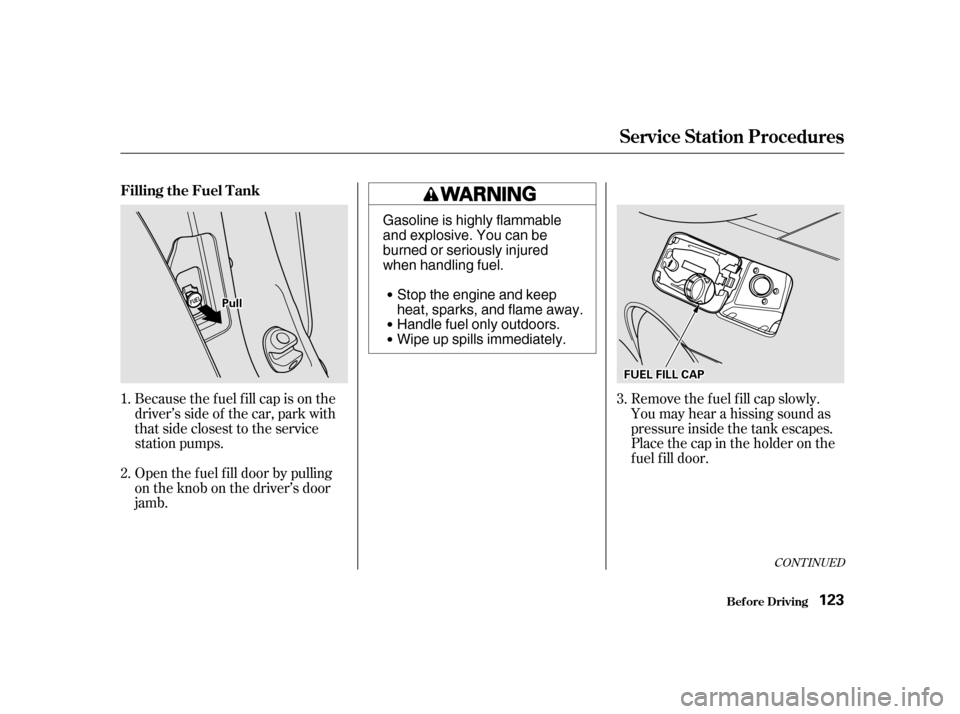
Removethefuelfillcapslowly.
You may hear a hissing sound as
pressure inside the tank escapes.
Place the cap in the holder on the
fuel fill door.
Because the f uel f ill cap is on the
driver’s side of the car, park with
that side closest to the service
station pumps.
Open the f uel f ill door by pulling
on the knob on the driver’s door
jamb.
1. 2.
3.
CONT INUED
Filling the Fuel Tank
Service Station Procedures
Bef ore Driving
123
PPuullll
FFUUEELLFFIILLLLCCAAPP
Gasoline is highly flammable
and explosive. You can be
burned or seriously injured
when handling fuel.
Stop the engine and keep
heat, sparks, and flame away.
Handle fuel only outdoors.
Wipe up spills immediately.
Page 123 of 277
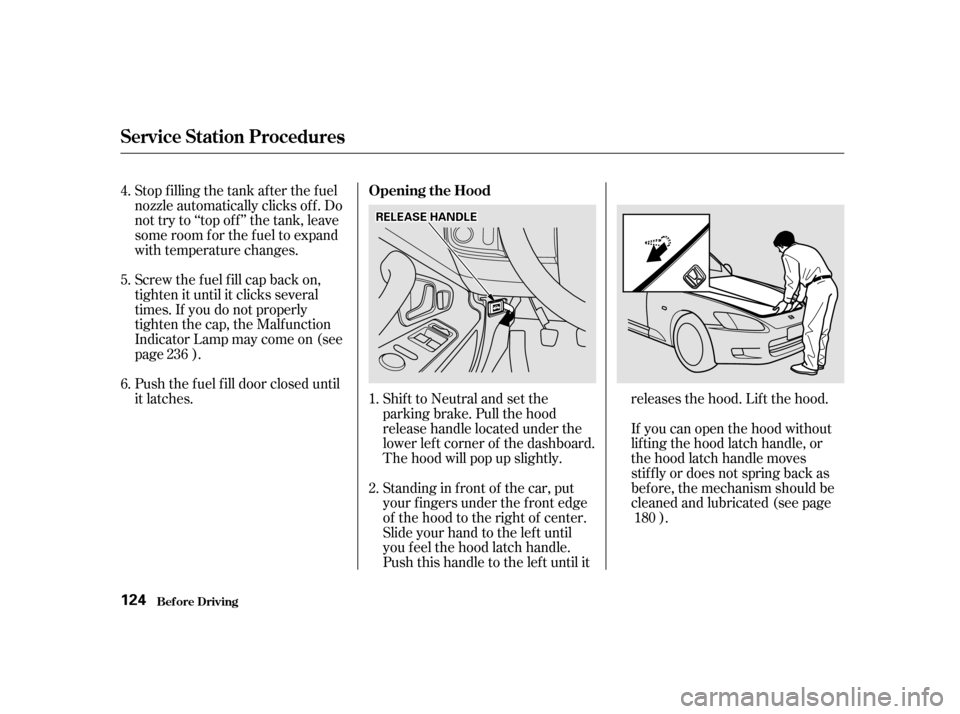
Screw the f uel f ill cap back on,
tighten it until it clicks several
times. If you do not properly
tighten the cap, the Malfunction
Indicator Lamp may come on (see
page ).
Push the f uel f ill door closed until
it latches.Standing in f ront of the car, put
your f ingers under the f ront edge
of the hood to the right of center.
Slide your hand to the lef t until
you f eel the hood latch handle.
Push this handle to the lef t until itreleases the hood. Lif t the hood.
If you can open the hood without
lifting the hood latch handle, or
the hood latch handle moves
stif f ly or does not spring back as
bef ore, the mechanism should be
cleaned and lubricated (see page
).
Stop f illing the tank af ter the f uel
nozzle automatically clicks of f . Do
not try to ‘‘top off’’ the tank, leave
some room f or the f uel to expand
with temperature changes.
Shif t to Neutral and set the
parking brake. Pull the hood
release handle located under the
lower lef t corner of the dashboard.
The hood will pop up slightly.
1.
4. 5.
2.
6.
236
180
Service Station Procedures
Bef ore DrivingOpening the Hood
124
RREELLEEAASSEEHHAANNDDLLEE
Page 124 of 277
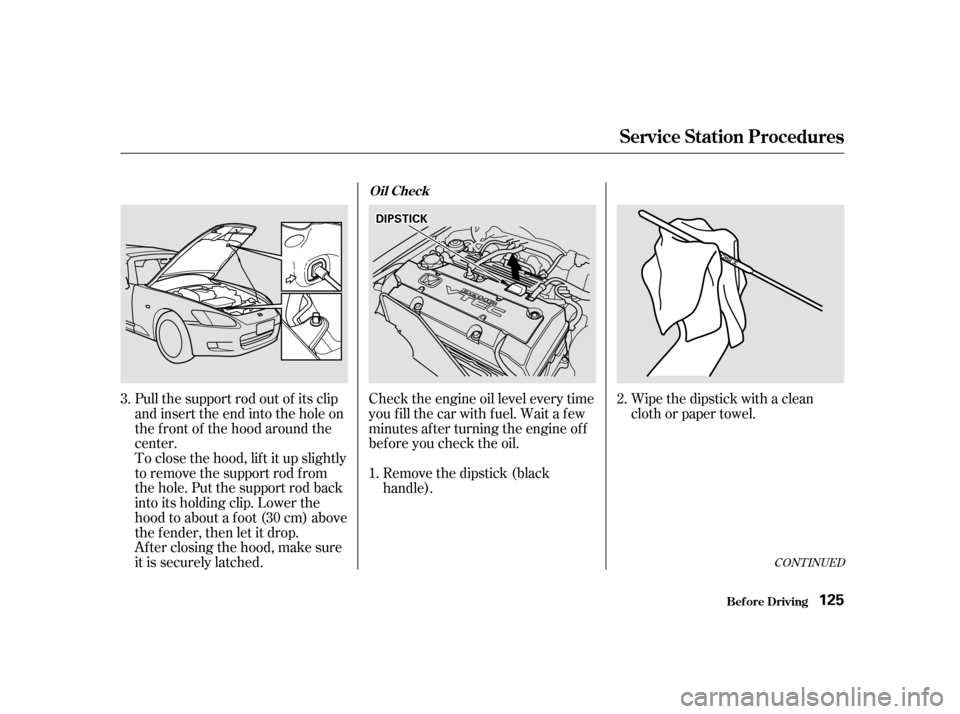
Pull the support rod out of its clip
and insert the end into the hole on
the f ront of the hood around the
center.
To close the hood, lif t it up slightly
to remove the support rod f rom
the hole. Put the support rod back
into its holding clip. Lower the
hood to about a f oot (30 cm) above
the fender, then let it drop.
After closing the hood, make sure
it is securely latched.Check the engine oil level every time
you f ill the car with f uel. Wait a f ew
minutes af ter turning the engine of f
bef ore you check the oil.
Remove the dipstick (black
handle). Wipe the dipstick with a clean
cloth or paper towel.
1.
3.
2.
CONT INUED
Oil Check
Service Station Procedures
Bef ore Driving125
DDIIPPSSTTIICCKK
Page 125 of 277
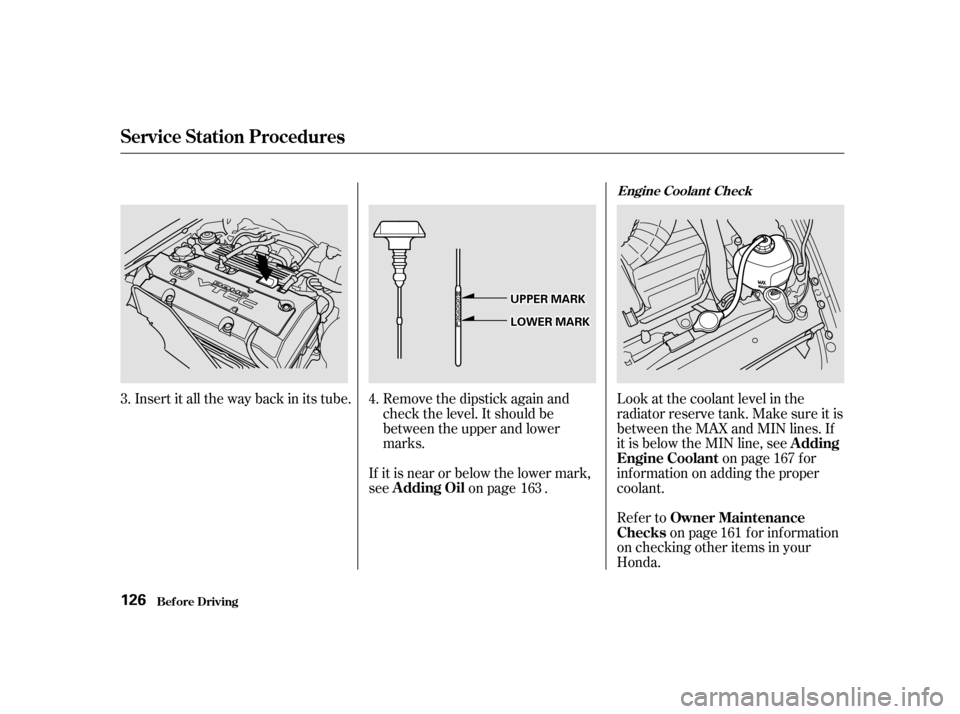
Insert it all the way back in its tube. Remove the dipstick again andcheck the level. It should be
between the upper and lower
marks.
If it is near or below the lower mark,
see on page . Look at the coolant level in the
radiator reserve tank. Make sure it is
between the MAX and MIN lines. If
it is below the MIN line, see
on page f or
informationonaddingtheproper
coolant.
Refer to on page f or inf ormation
on checking other items in your
Honda.
3.
4.
163 167
161
Service Station Procedures
Bef ore Driving A dding Oil
A dding
Engine Coolant
Owner Maintenance
Checks
Engine Coolant Check
126
UUPPPPEERRMMAARRKK
LLOOWWEERRMMAARRKK
Page 126 of 277

You can improve f uel economy by
driving moderately. Rapid acceler-
ation, abrupt cornering, and hard
braking use more f uel.
Always drive in the highest gear that
allows the engine to run and acceler-
ate smoothly.
A cold engine uses more f uel than a
warm engine. It is not necessary to
‘‘warm-up’’ a cold engine by letting it
idle f or a long time. You can drive
away in about a minute, no matter
how cold it is outside. The engine
will warm up f aster, and you get
better f uel economy. To cut down on
the number of ‘‘cold starts,’’ try tocombine several short trips into one.
The condition of your car and your
driving habits are the two most
important things that affect the fuel
mileage you get.
Always maintain your car according
to the maintenance schedule. This
will keep it in top operating condition.
Depending on traf f ic conditions, try
to maintain a constant speed. Every
time you slow down and speed up,
your car uses extra f uel. Use the
cruise control, when appropriate, to
increase f uel economy.The air conditioning puts an extra
load on the engine which makes it
usemorefuel.Turnoff theA/Cto
cutdownonairconditioninguse.
Use the f low-through ventilation
when the outside air temperature is
moderate.
In winter, the build-up of snow on
your car’s underside adds weight and
rolling resistance. Frequent cleaning
helps your f uel mileage and reduces
thechanceof corrosion.
An important part of that mainte-
nance is the
(see page ). For
example, an underinf lated tire
causes more ‘‘rolling resistance,’’
which uses f uel. It also wears out
f aster, so check the tire pressure at
least monthly. 161 Driving Habits
Car Condition
Owner Maintenance
Checks
Bef ore Driving
Fuel Economy
127
Page 127 of 277

When properly installed, cellular
phones, alarms, two-way radios, and
low-powered audio systems should
not interf ere with your car’s
computer-controlled systems, such
as the SRS and anti-lock brake
system.If possible, have your dealer inspect
the f inal installation.Be sure electronic accessories do
not overload electrical circuits
(see page ).
Make sure the accessory does not
obscure any lights, or interf ere
with proper car operation or
perf ormance.
Bef ore installing any accessory:
However, if electronic accessories
are improperly installed, or exceed
your car’s electrical system capacity,
they can interfere with the operation
of your car, or even cause the
airbags to deploy.
Modif ying your car, or installing
some non-Honda accessories, can
make your car unsaf e. Bef ore you
make any modif ications or add any
accessories,besuretoreadthe
f ollowing inf ormation.
Your dealer has genuine Honda
accessories that allow you to
personalize your car. These
accessories have been designed and
approved f or your car, and are
covered by warranty.
Non-Honda accessories are usually
designed f or universal applications.
Although aftermarket accessories
may f it on your car, they may not
meet f actory specif ications, and
could adversely af f ect your car’s
handling and stability. (See
‘‘Modif ications’’ on page f or
additional information.)
Have the installer contact your
Honda dealer f or assistance bef ore
installing any electronic accessory.
129 241
A ccessories
A ccessories and Modif ications
Bef ore Driving
128 Improper accessories or
modifications can affect your
car’s handling, stability and
performance, and cause a
crash in which you can be hurt
or killed.
Follow all instructions in this
owner’s manual regarding
accessories and modifications.
Page 128 of 277

In addition, any modif ications that
decrease ground clearance increase
the chance of undercarriage parts
striking a curb, speed bump, or other
raised object, which could cause
your airbags to deploy.
Do not modif y your steering wheel
or any other part of your
Supplemental Restraint System.
Modif ications could make the
system inef f ective.
Do not remove any original
equipment or modif y your car in any
way that would alter its design or
operation. This could make your car
unsaf e and illegal to drive.
For example, do not make any
modif ications that would change the
ride height of your car, or install
wheels and tires with a dif f erent
overall diameter.
Such modif ications can adversely
af f ect handling, and interf ere with
the operation of the car’s anti-lock
brakes and other systems. Do not attach or place objects on the
airbag covers. Any object attached to
or placed on the covers marked ‘‘SRS
AIRBAG,’’ in the center of the
steering wheel and on top of the
dashboard, could interf ere with the
proper operation of the airbags. Or,
if the airbags inf late, the objects
could be propelled inside the car and
hurt someone.
Modif ications
Additional Saf ety Precaution
A ccessories and Modif ications
Bef ore Driving129
Page 129 of 277
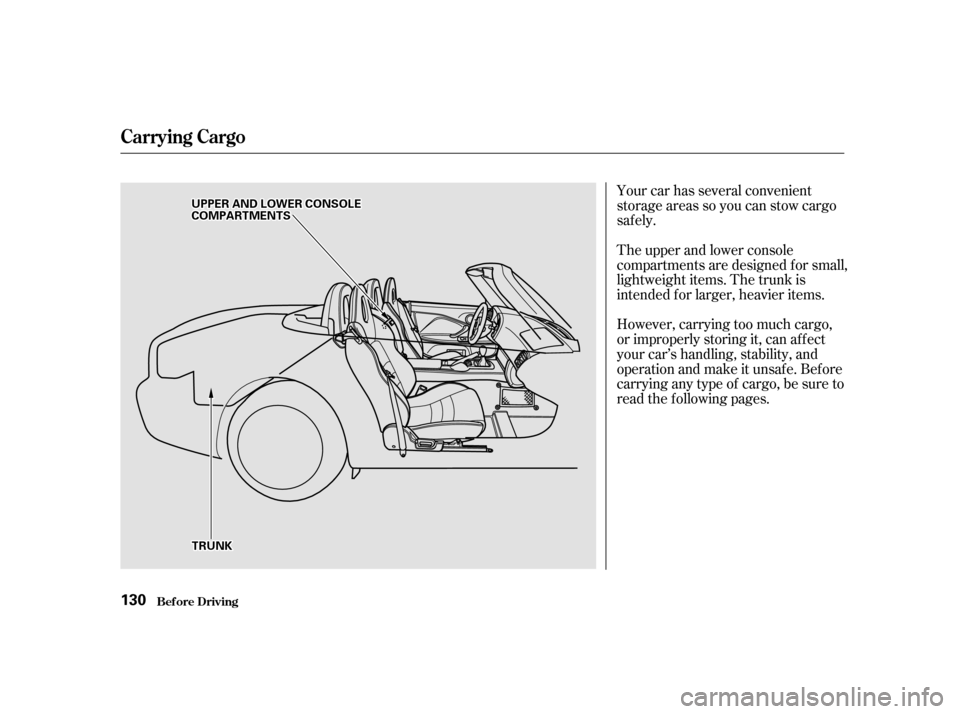
Your car has several convenient
storage areas so you can stow cargo
saf ely.
However, carrying too much cargo,
or improperly storing it, can af f ect
your car’s handling, stability, and
operation and make it unsafe. Before
carrying any type of cargo, be sure to
read the f ollowing pages.
The upper and lower console
compartments are designed for small,
lightweight items. The trunk is
intended f or larger, heavier items.
Bef ore Driving
Carrying Cargo
130
UUPPPPEERRAANNDDLLOOWWEERRCCOONNSSOOLLEECCOOMMPPAARRTTMMEENNTTSS
TTRRUUNNKK
Page 130 of 277

Store or secure all items that could
be thrown around and hurt
someone during a crash.
Besureitemsplacedonthefloor
behind the f ront seats cannot roll
under the seats and interf ere with
the driver’s ability to operate the
pedals, or with the proper
operation of the seats.
This f igure includes the total weight
of all occupants, cargo, and
accessories.
To f igure out how much cargo you
can carry:
Add up the weight of all occupants.
Subtract the total f rom 400 lbs
(185 kg).
The f inal number is the total weight
of cargo you can carry.
The maximum load for your car is
400 lbs (185 kg).
Carrying Items in the Passenger
Compartment
Load Limit
Carrying Cargo
Bef ore Driving
131
Overloading or improper
loading can affect handling and
stability and cause a crash in
which you can be hurt or killed.
Follow all load limits and other
loading guidelines in thismanual.